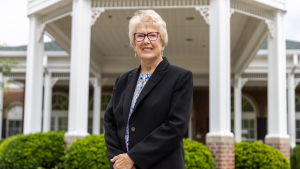Advanced practice registered nurses key to improving nursing home care, SSON study finds
University of Missouri researcher finds APRNs are often overlooked, underutilized in nursing homes.
Dec. 12, 2022
When Alisha Johnson worked in a Texas hospital, she noticed the same elderly patients being repeatedly transferred from nearby nursing homes after their health had once again severely declined.
“It was always the same problems — they came to me really sick with health issues that should have been taken care of much sooner, before they got to me in a hospital,” Johnson said. “It seemed like a waste, and it seemed too hard on these patients because I could tell they were traumatized from being repeatedly transferred from the nursing home where they lived. I knew we could do more to prevent this.”
Now an assistant professor in the MU Sinclair School of Nursing, Johnson researches the successes and challenges of transitioning advanced practice registered nurses, or APRNs, into nursing homes in an effort to improve health outcomes for residents and to reduce the number of residents being repeatedly transferred to hospitals. For a recent study, she spent a year interviewing APRNs about their transition to the nursing home setting and whether their presence there had an impact on improved decision-making that ultimately improved resident health outcomes.
Johnson found that while the transition was rocky for some, the change was smoother when the nursing home staff welcomed the APRNs’ advanced expertise and saw them as collaborators rather than competitors in their current reimbursement structure.
“The staff that works in nursing homes are wonderful, caring people, but what I found was often a lack of understanding of the beneficial expertise the APRNs can provide, as they have advanced training in pharmacology, diagnostics, lab work, blood tests, radiology, early illness detection and medications, and this broadens their ability to direct care decisions that ultimately improve resident health outcomes,” Johnson said. “Also, medical providers are often reimbursed for assessments they give to nursing home residents, so we might want to look at modifying the reimbursement structure in a way that encourages collaboration with APRNs rather than leaving them on the sidelines or viewing them as competition for reimbursement dollars.”
Currently, when nursing home residents need care, nurses or aides must first contact a physician who is often not present in the nursing home, forcing the ailing resident to wait for a treatment plan. Ultimately, this delayed action can lead to miscommunication, declining resident health outcomes and costly, stressful and avoidable transfers to the hospital.
“APRNs have a huge opportunity to fill these care gaps, as research shows residents receive much better care if they stay in the nursing home where they live rather than being transferred to a hospital,” Johnson said. “APRNs can see what is going on in real time and make care decisions much more quickly.”
A 2021 study by MU researchers evaluated the effectiveness of the Missouri Quality Improvement Initiative, a $35 million program funded by the Centers for Medicare and Medicaid that implemented APRNs full time into 16 Missouri nursing homes. They found the APRNs improved the quality of care for nursing home residents, resulting in reduced avoidable hospitalizations and emergency room visits, leading to better overall health and more than $31 million in savings. Each year, billions of dollars are spent transferring residents from nursing homes to hospitals, and MU researchers have found many of these transfers could have been avoided through early illness detection and quicker decision-making within the nursing home.
“Missouri currently has a state requirement that APRNs can’t provide assessments or write orders independently, they must work under a physician, but research shows states that do not have this requirement have just as good health outcomes among their nursing home residents,” Johnson said. “The number of physicians working in geriatrics is decreasing, and there are three times as many APRNs working in long-term care facilities than physicians. So, APRNs can provide tremendous benefits in nursing homes when given the opportunity.”
Johnson recently earned a $200,000 grant from The Donaghue Foundation to further study how APRNs can improve the quality of care delivered to nursing home residents.
“We need decision makers that can do the right things for residents and APRNs can fill that gap,” Johnson said. “We just need to figure out how to better use them, better support them and ensure they are being paid appropriately. It feels great to work on this because it is an under-researched area, and I am excited to be a part of it.”
“Advanced practice registered nurse transition to practice in the long-term care setting: An ethnography” was published in Global Nursing Qualitative Research.
Story written by Erin O’Connell
Story originally published December 9, 2022 at Show Me Mizzou


